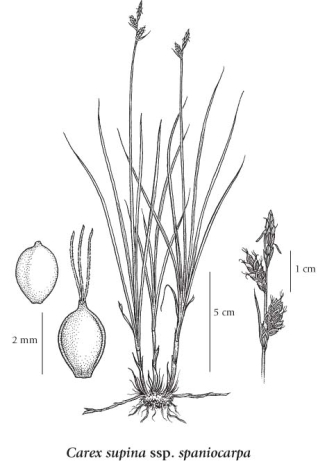Carex supina subsp. spaniocarpa Willd. ex Wahlenb. (Steud.) Hulten
spreading arctic sedge
Cyperaceae (Sedge family)
Introduction to Vascular Plants
spreading arctic sedge
Cyperaceae (Sedge family)
Introduction to Vascular Plants
Map
Distribution of Carex supina subsp. spaniocarpa
Click here to view the full interactive map and legend
Species Information
General:
Perennial, loosely tufted herb from short, spreading rhizomes; stems 4-20 cm tall, sharply triangular, roughened, clustered, longer than the leaves.
Leaves:
Sheaths tight, brownish; blades 4 to 8, flat or more or less channeled, borne on the lower 1/3 of the stem, 0.5-1.8 mm wide, the lower ones reduced.
Flowers:
Spikes 2 to 4, the terminal one linear, 10-13 mm long, stalked, with male flowers, the lower spikes 1 to 3, egg-shaped, few-flowered, with female flowers, unstalked to short-stalked, erect to spreading; bracts subtending the female spikes scalelike, awned, sheathless, slightly longer to slightly shorter than the spikes, the lowest one with conspicuous, translucent, ear-shaped lobes.
Fruits:
Perigynia elliptical to egg-shaped, 2.5-3.5 mm long, 1.4-1.8 mm wide, yellowish-green to brown, smooth, shiny, with 2 prominent marginal nerves, short-stalked, the beaks short, obliquely cut, 0.4-0.8 mm long; female scales broadly egg-shaped, pointed or sometimes shortly awned, shorter than the perigynia, chestnut-brown, with lighter midribs and translucent margins; stigmas 3; achenes 3-angled, smooth, 1-1.6 mm long.
Illustration

If more than one illustration is available for a species (e.g., separate illustrations were provided for two subspecies) then links to the separate images will be provided below. Note that individual subspecies or varietal illustrations are not always available.
Illustration Source: The Illustrated Flora of British Columbia
Habitat and Range
Dry rocky or sandy, grassy slopes and rock outcrops in the montane zone; rare in WC BC, infrequent in N BC; circumpolar, N to AK, YT and NT, E to PQ and S to MN; Greenland, Eurasia.Status Information
Synonyms
Synonyms and Alternate Names:
Carex spaniocarpa
